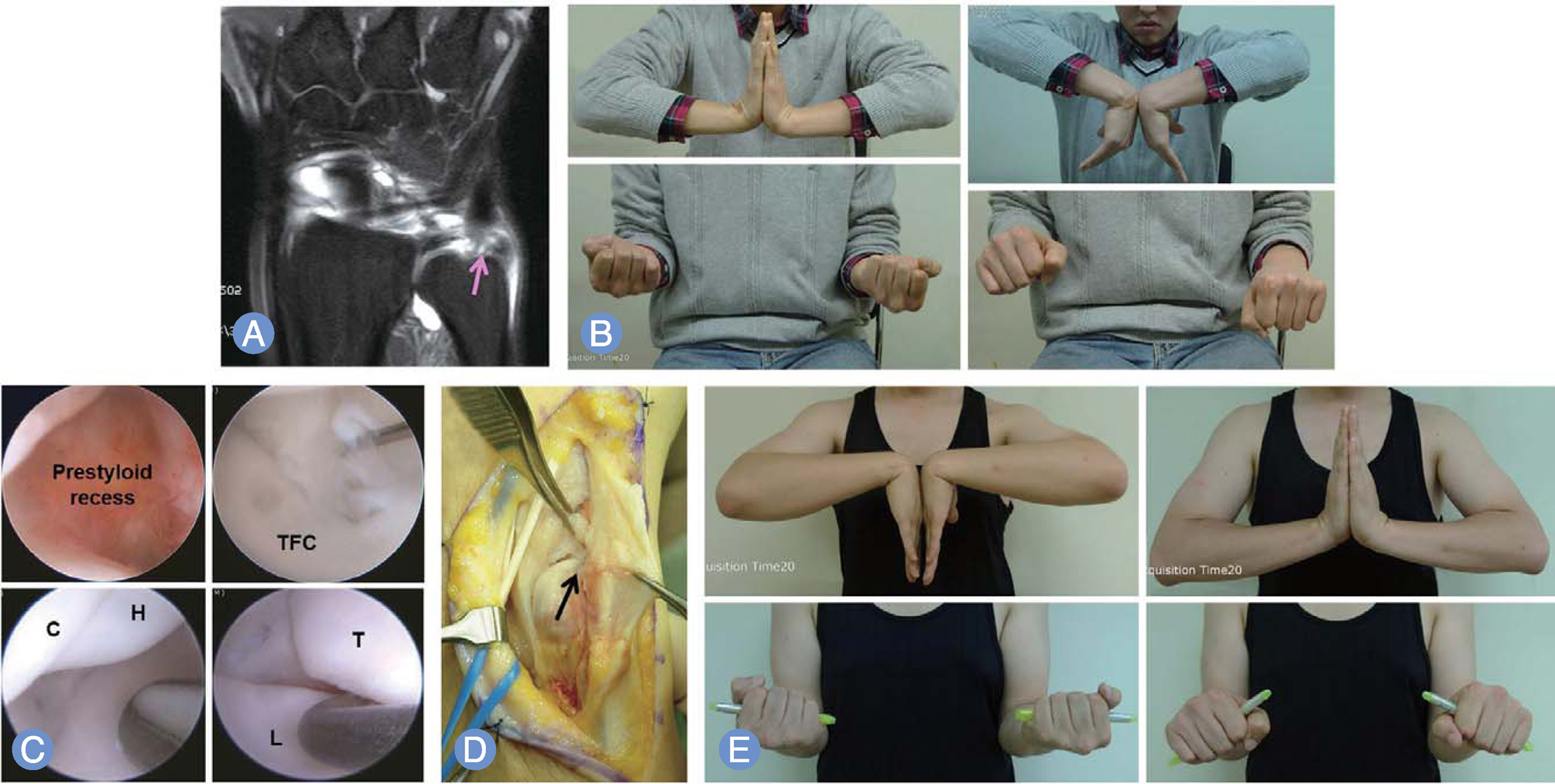J Korean Soc Surg Hand.
2014 Dec;19(4):159-166. 10.12790/jkssh.2014.19.4.159.
Clinical Outcomes of Open Surgical Repair for Triangular Fibrocartilage Complex Foveal Detachment
- Affiliations
-
- 1Upper Extremity and Microsurgery Center, Semyeong Christianty Hospital, Pohang, Korea. osdrrih@gmail.com
- KMID: 1896904
- DOI: http://doi.org/10.12790/jkssh.2014.19.4.159
Abstract
- PURPOSE
To investigate short term clinical outcomes of the open surgical repair for triangular fibrocartilage complex (TFCC) foveal detachment.
METHODS
We retrospectively reviewed 8 patients (5 men, 3 women) who had been treated with open surgical repair of the TFCC type 1B injury, from 2005 to 2013 and who were followed up for more than one year after surgery. Mean age at time of surgery was 34 years. The right side was involved in 3 patients, and the left in 5. The clinical results of surgery were assessed with modified Mayo wrist score (MMWS), disabilities of the arm, shoulder and hand (DASH) score and pain-visual analogue scale (VAS). Physical examination was performed to evaluate the prescence of distal radioulnar instability, preoperatively and at the latest follow-up.
RESULTS
The mean follow up period were 36.5 months (range, 12-64 months). The mean MMWS improved from 52.5 (range, 25-85) preoperatively to 82.5 (range, 75-100) postoperatively (p=0.02). The mean DASH score improved from 39.6 (range, 65-13.5) preoperatively to 13.4 (range, 2.5-33.3) postoperatively (p=0.012). The preoperative mean pain-VAS was 4.6 (range, 6-3); these value was reduced to mean 2 (range, 0-3) at the latest follow-up (p=0.016). There were no patients remaining instability after the surgery, although four patients showed distal radioulnar joint (DRUJ) instability before surgery.
CONCLUSION
The surgical outcomes of open repair for TFCC foveal detachment (type 1B) was contentable. Also, in cases of type 1B injury associated with DRUJ instability were managed sucessfully without additional procedure.
Keyword
MeSH Terms
Figure
Reference
-
1. Millants P, De Smet L, Van Ransbeeck H. Outcome study of arthroscopic suturing of ulnar avulsions of the triangular fibrocartilage complex of the wrist. Chir Main. 2002; 21:298–300.
Article2. Lindau T, Adlercreutz C, Aspenberg P. Peripheral tears of the triangular fibrocartilage complex cause distal radioulnar joint instability after distal radial fractures. J Hand Surg Am. 2000; 25:464–8.
Article3. Iwasaki N, Minami A. Arthroscopically assisted reattachment of avulsed triangular fibrocartilage complex to the fovea of the ulnar head. J Hand Surg Am. 2009; 34:1323–6.
Article4. Atzei A, Rizzo A, Luchetti R, Fairplay T. Arthroscopic foveal repair of triangular fibrocartilage complex peripheral lesion with distal radioulnar joint instability. Tech Hand Up Extrem Surg. 2008; 12:226–35.
Article5. Haugstvedt JR, Berger RA, Nakamura T, Neale P, Berglund L, An KN. Relative contributions of the ulnar attachments of the triangular fibrocartilage complex to the dynamic stability of the distal radioulnar joint. J Hand Surg Am. 2006; 31:445–51.
Article6. Chou KH, Sarris IK, Sotereanos DG. Suture anchor repair of ulnar-sided triangular fibrocartilage complex tears. J Hand Surg Br. 2003; 28:546–50.
Article7. Sennwald GR, Lauterburg M, Zdravkovic V. A new technique of reattachment after traumatic avulsion of the TFCC at its ulnar insertion. J Hand Surg Br. 1995; 20:178–84.
Article8. Hermansdorfer JD, Kleinman WB. Management of chronic peripheral tears of the triangular fibrocartilage complex. J Hand Surg Am. 1991; 16:340–6.
Article9. Nakamura T, Sato K, Okazaki M, Toyama Y, Ikegami H. Repair of foveal detachment of the triangular fibrocartilage complex: open and arthroscopic transosseous techniques. Hand Clin. 2011; 27:281–90.
Article10. Nakamura T, Nakao Y, Ikegami H, Sato K, Takayama S. Open repair of the ulnar disruption of the triangular fibrocartilage complex with double three-dimensional mattress suturing technique. Tech Hand Up Extrem Surg. 2004; 8:116–23.
Article11. Cooney WP, Linscheid RL, Dobyns JH. Triangular fibrocartilage tears. J Hand Surg Am. 1994; 19:143–54.
Article12. Jester A, Harth A, Germann G. Measuring levels of upper-extremity disability in employed adults using the DASH Questionnaire. J Hand Surg Am. 2005; 30:1074.e1–e10.
Article13. Estrella EP, Hung LK, Ho PC, Tse WL. Arthroscopic repair of triangular fibrocartilage complex tears. Arthroscopy. 2007; 23:729–37.e1.
Article14. Hudak PL, Amadio PC, Bombardier C. Development of an upper extremity outcome measure: the DASH (disabilities of the arm, shoulder and hand) [corrected]. The Upper Extremity Collaborative Group (UECG). Am J Ind Med. 1996; 29:602–8.15. SooHoo NF, McDonald AP, Seiler JG 3rdr, McGillivary GR. Evaluation of the construct validity of the DASH questionnaire by correlation to the SF-36. J Hand Surg Am. 2002; 27:537–41.
Article16. Moritomo H, Masatomi T, Murase T, Miyake J, Okada K, Yoshikawa H. Open repair of foveal avulsion of the triangular fibrocartilage complex and comparison by types of injury mechanism. J Hand Surg Am. 2010; 35:1955–63.
Article17. Moritomo H. Advantages of open repair of a foveal tear of the triangular fibrocartilage complex via a palmar surgical approach. Tech Hand Up Extrem Surg. 2009.
Article
- Full Text Links
- Actions
-
Cited
- CITED
-
- Close
- Share
- Similar articles
-
- Surgical Technique for Repairing Foveal Tear of the Triangular Fibrocartilage Complex: Arthroscopic Knotless Repair
- Surgical Techniques for Repairing Foveal Tear of the Triangular Fibrocartilage Complex: Arthroscopic Transosseous Repair
- Open Repair of Triangular Fibrocartilage Complex Type 1B Tear
- Arthroscopic Repair of Triangular Fibrocartilage Complex Tear
- Effective Functional Recovery after Triangular Fibrocartilage Complex Foveal Repair



